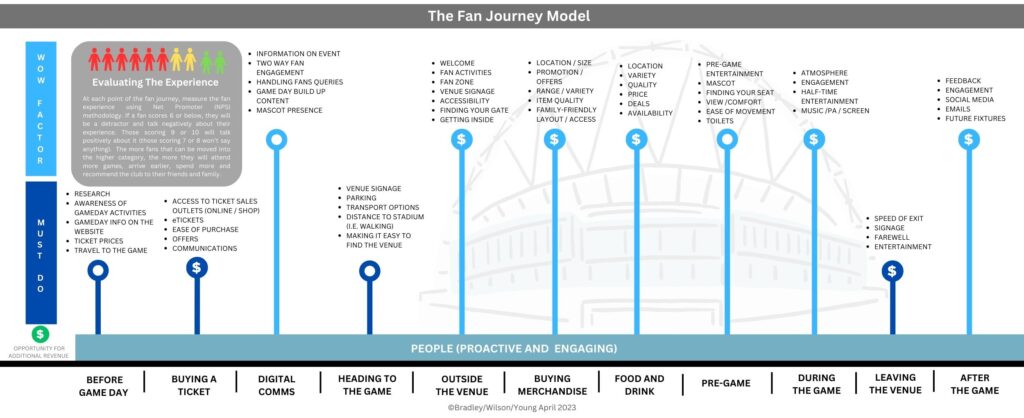The Fans Journey - Part 7: Buying Merchandise
While many of the steps in a fan journey have to happen – for example, getting a ticket, travelling to the game and spending time both outside and inside the stadium – one that doesn’t have to take place is the purchasing of merchandise.
That purely comes down to choice.
A fan doesn’t even need to see the retail offering if they choose not to. If it’s in a megastore, smaller shop or just on a table by the turnstile, for example, we can simply decide to give it a miss. Online sales require us to go look at the website too. So it’s fair to say that this step in the journey is really down to us as individuals.
But is it?
The club can play a huge part in our decisions too. The onus is on them to make fans want to look at the merchandise, not swerve past it on a match day. If they don’t look, they won’t buy, and clubs of all sizes can make a tidy sum from sales of merchandise on a match day.
Yet a number of clubs seem to treat is as a necessary evil: a must-have, box-ticker but not one that is designed with the fan in mind, and especially not their enjoyment.

Mark Bradley
@fanexperienceco
Mark founded the Fan Experience Company in 2005 to build attendance growth and community engagement on the basis of improving fan experiences. He recently created FC Barcelona’s Barça Innovation Hub’s first fan engagement study certificate. The Fan Experience Company has undertaken more than 3,500 fan experience assessments in many countries for clients as diverse as The Danish Superliga, The EFL, The WSL / WC, United Rugby and Premiership Rugby.

Geoff Wilson
@fanexperienceco
Geoff runs his own Sports Consultancy, working with clients such as FIFA, UEFA, AFC and FIBA across the world. He is also on the board of Tourism Northern Ireland. You can follow Geoff on twitter @geoffwnjwilson connect on Linkedin at linkedin.com/in/geoffwnjwilson

Darren Young
@fanexperienceco
Darren joined the Fan Experience Company in 2017. He has an MBA with a background in customer service excellence having worked as a consultant in that field for a number of years. As well as being responsible for all of the assessment summary reports that are produced each season, he has also worked with a number of clubs on an individual basis, including Lincoln City, Walsall, Grimsby Town, Nottingham Forest and OH Leuven on projects ranging from staff development to supporter feedback surveys.
A Destination? Or Means To An End?
Very often the store is a means to an end; simply a vehicle from which to sell either kit or other branded merchandise. Clubs fail to pay close attention to how the retail and merchandise experience can be integrated into the match day so that it not only becomes a useful source of additional revenue but plays its part in making the overall experience better.
Think of the cramped shops you’ve squeezed into. The ones where the most interesting items are positioned exactly where the queues lines are, so you have to either join the queue and make a very quick decision or don’t look at all. Think of the items behind a counter or a glass screen so there is no opportunity to touch and feel (presumably because the club thinks everyone is only in there to nick stuff – note to clubs: this isn’t Sports Direct, most fans just want to see what they are purchasing before they part with their hard-earned cash.) Think too of the shops that only have replica kit, or where any staff are almost as scarce as decent products. What about those that have no pricing on any of the goods?
At smaller clubs outside of the professional leagues, merchandise sometimes isn’t there at all. This is an oversight because replica shirts, club-branded clothing and even a pin badge or car sticker not only provides an income stream but also helps to spread the club’s identity far and wide; much further and wider than it would get otherwise.
In our trip to the World Cup in 2022, this touchpoint was a rare example of a part of the fan journey where the ball was dropped. Stores at the eight stadiums didn’t exactly inspire with no queue management, no prices (to begin with anyway), no changing rooms, few staff and worst of all, an untidy layout. If you go into any shop – for anything - and there are cardboard boxes scattered everywhere and hundreds of people climbing on top of each other to move around, it doesn’t exactly make you want to stay there and spend lots of money does it? So we can’t blame fans if they decide to walk on by or leave without purchasing.
It’s time that clubs understood the power of the overall retail experience. You can build it, but they won’t come unless you give them a compelling reason. With shirts nearing the one hundred pound barrier, they aren’t going to come for the value-for-money either. But rather than tell you what’s wrong with the current experience at so many stadiums, let’s reverse it and look at what it could be like. So imagine this….(you can scale your imagination up or down depending on the size of your club).
In the build-up to a game you’re going to, there are promotional messages that tell you that there is a store(s) at the stadium, where they are and what time they open and close. These messages aren’t trying to sell, sell, sell but rather inform. They might provide details of some of the items or point you towards a sale, but their main purpose is to make you want to come inside when you arrive.
On arrival, the store is better described as a destination. The place is really easy to find, looks great from the outside with plenty of colourful branding and imagery and there is plenty of room too. In fact, it’s the perfect place to meet your friends or family members before kick-off. On this occasion, the club mascot is outside posing for selfies and high fiving everyone, including you. You knew they’d be there at this time; the club said so in their emails.
You go inside and the layout is designed to make it really easy to see everything. You can walk around freely and browse. Items that appeal are at the right height, kept in one easily accessible place to make them easier to find and look at. They are all clearly priced too, so there is no confusion about what the cost of any purchases will be when you get to the tills.
A floor-walker is there to answer questions and make sure fans can find what they are looking for. They are smiling and proactively on the lookout for anyone who needs help, might be lost or has something that they want to ask. They don’t pressure anyone though, they are all about help, not hassle.
Imagine the staff behind the tills are great too. They engage with fans, ask questions and never stop smiling either. They say ‘enjoy the game’ when fans leave and you even get another high five by the exit door. They ask you what you think the score might be and say they hope to see you again at a future game. They seem really interested in you as a fan, not just someone they want to sell to.
The real plus point is the range though. It’s massive, with loads aimed at younger fans. They have lots of pocket-money-priced items that really appeal including stationery with the club’s branding, water bottles, sweets, socks, keyrings, footballs, a sticker pack, wallets, foam fingers as well as the usual clothing, hats and scarfs, There are some really unusual items too, things you don’t see very often like the team bus made from Lego. The cuddly versions of the club mascot are brilliant as well.
As a bonus, one of the players who is not in the match day squad (they are one of your favourites but out injured although thankfully on the mend) has made a brief appearance to pose for a few pictures, sign some autographs (to help with this, the club sell autograph cards with their image and a space for the message) and show his / her appreciation for the fans and their support. As you leave the store, they catch your eye and thank you for coming to the game.
And now imagine you are nine years old.


If you’d like help with this or other game day touch points, then make sure to listen in to The Fan Experience Experience podcast (on Spotify, Apple Podcasts and via Buzzsprout); to visit www.fanexperienceco.com or to email us via [email protected].
Mark Bradley, Geoff Wilson and Darren Young assessed the fan experience at eight matches at the 2022 World Cup in Qatar. Click here to read more about what they found there.